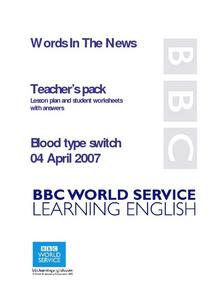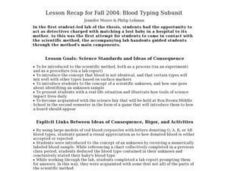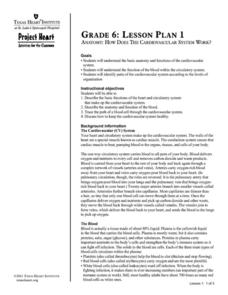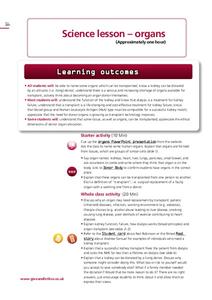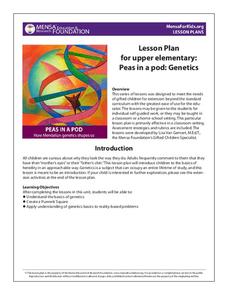Curated OER
Were the babies switched? – The Genetics of Blood Types
Human biology or genetics learners apply their knowledge to a unique situation: two newborn baby girls being possibly switched in the hospital. The engaging activity ends with a Punnett squares assignment in which pupils...
Curated OER
Using Blood-Typing to Determine Causes of Death in Surgery Patients
In this simulation activity, young biologists examine blood types to determine whether the death rate in a hospital was caused because of incorrect identification of patient blood types. You will need obtain and follow the procedures of...
Give and Let Live
Blood and Transplant: Blood
Why is blood donation so important, anyway? Science and health classes across multiple grades benefit from an in-depth look into the need for and process of blood donation. With an emphasis on presenting the topic in a non-threatening...
Curated OER
Blood Type
In this blood type worksheet, students create a wheel showing blood type, antigens and the genes involved in coding for each blood type. Students use the wheel to answer 16 questions about blood type and they complete a chart with the...
Curated OER
Blood type Switch
Students read a text about blood groups and answer such questions as what, where and why regarding a scientific discovery. They complete vocabulary worksheets, comprehension exercises and utilize problem solving skills to decide who...
Curated OER
Blood Typing Subunit
Pupils play the role of science detectives in an activity used to introduce the scientific method and the concept that blood is not identical and is identified by surface markers. Students must identify an unknown sample of "blood" by...
National WWII Museum
A New War Weapon to Save Lives
Young historians view and analyze photos and documents from WWII that are related to blood transfusions and blood plasma. A demonstration of correct and incorrect blood donors visually shows the importance of knowing blood...
Curated OER
Human Blood: Microviewer
In this human blood: microviewer instructional activity, students answer questions about blood, red blood cells, white blood cells, phagocytosis, blood type B, fibrin, sickle cells, and infected blood. Students also draw quick sketches...
Curated OER
" Where in the World is Your Blood Type?
Students explore a map of the worldwide distribution of blood types and observe the patterns. In this blood type lesson students conduct a lab and determine the geographic distribution of the different blood types and determine a...
Curated OER
Born of Blood: Inheritance of Blood Types
Students examine inheritance of blood types. In the chromosome activity, students create a model of chromosome and predict the blood type of offspring.
Curated OER
Valentine Science Blood Types
Students explore blood types. In this science investigation lesson, students participate in a classroom simulation that replicates a blood transfusion so that students may note how the 4 blood types interact.
Curated OER
Blood Cell Basics
Students design a proportional model of blood out of red gelatin, a plastic bag, and rice. They study the components that make up blood and investigate what happens when the arteries in different scenerios. They work in pairs in order to...
Texas Heart Institute
Anatomy: How Does the Cardiovascular System Work?
How can the circulatory system compare to a city map? Pupils distinguish the "roadways" and "vehicles" of the cardiovascular system, compare the anatomy and function of veins and arteries, and review different types of blood cells with...
Manitoba Education and Early Childhood Learning
Forensic Sciences: A Crime Scene Investigation Unit
Mr. Bergman has been murdered and we need you to solve the crime! The cross-curricular unit covers 11 different types of forensic science and includes 17 activities. Scholars perform blood type analysis, blood spatter analysis,...
Curated OER
Born of Blood
Eighth graders use a large Punnett Square and infer how genes determine blood types. In this blood type lesson plan students predict blood types and demonstrate how Punnett Squares are related to genes and chromosomes.
Give and Let Live
Blood and Transplant: Organs
Who donates organs, and how do organ donations work? The third lesson in a four-part series discusses the tremendous need for donor organs of all ages and backgrounds. A variety of materials, included with the teacher's guide, walk...
Curated OER
Using Blood Tests to Identify Babies and Criminals
Students solve a crime by matching a suspect's blood type to physical evidence collected at the crime scene. In this forensic science instructional activity, students identify the different blood types. They explain how blood tests work.
Curated OER
Blood
In this blood worksheet, students describe the four functions of blood. Then they write what each part of the human body illustrated does below the picture. Students also complete the table on possible blood types of a receiver and donor...
Texas Heart Institute
Exercise: What Kinds of Activities Are Best?
What happens in the muscles during anaerobic and aerobic exercise, and how does this affect the heart and our overall health? A cross-curricular instructional activity that introduces learners to the lifelong benefits of exercise,...
MENSA Education & Research Foundation
Peas in a Pod: Genetics
Can peas have grandparents? Learn about inherited traits and heredity with a set of activities focused on Mendelian genetics. As your class learns about the process of passing traits along in Punnett squares, they take on the role of...
Curated OER
Who Done It?
Pick and choose which activities to include in this crime scene investigation. Junior detectives can examine fingerprints, DNA, blood samples, or bone structure. The plan suggests you have teams solve a mystery, but it does not...
Baylor College
Activity and Exercise
Leave it to the classic jump rope to get your class excited about physical activity! Your class will begin by discussing the benefits of jumping rope as a form of exercise and learning a few different types of jumps. Then in groups of...
Curated OER
Antibody Center Template
In this antibodies worksheet, students use model diagrams of antigens, antibodies and blood cells to develop a visual understanding of the immune system. They draw diagrams of antibodies and antigens attached to each other and answer...
Curated OER
How Do White Blood Cells Fight Foreign Organisms That Invade Our Body?
Ninth graders investigate the functions of white blood cells. They watch and discuss an online movie, conduct Internet research, and complete a worksheet.




